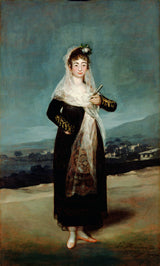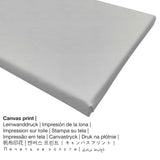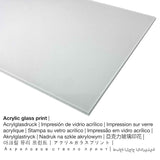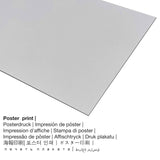Francisco de Goya, 1804 - Eserese nke Marquise de Santiago - mbipụta nka mara mma
Ụtụ gụnyere. Mbupu gbakọrọ na ndenye ọpụpụ.
Nhọrọ akụrụngwa gị
Maka mbipụta nka ọ bụla mara mma anyị na-enye ụdị nha na ihe dị iche iche. Họrọ n'ime nhọrọ ngwaahịa ndị a ugbu a ka ị kwekọọ na mmasị gị na nha na akụrụngwa:
- Mbipụta iko acrylic na-egbuke egbuke (ya na mkpuchi iko n'ezie): An print on acrylic glass, which is sometimes referred to as a UV print on plexiglass, will change your favorite original artwork into marvellous décor. The work of art is being made with modern UV print technology.
- Aluminom dibond (ọkpụkpụ ọla): Aluminium Dibond prints are metal prints with a true effect of depth. The bright & white components of the original work of art shine with a silky gloss, however without the glow.
- Mbipụta akwụkwọ mmado (ihe kwaaji): The poster is a printed sheet of cotton canvas with a slightly roughened structure on the surface, that reminds the original work of art. Please note, that depending on the size of the canvas poster print we add a white margin of around 2-6cm around the print in order to facilitate the framing with your custom frame.
- Kwaaji: A canvas print, which should not be confused with a canvas painting, is a digital replica printed on a UV direct printer. It makes the typical effect of three-dimensionality. Hanging a canvas print: Canvas Prints have the great advantage of being relatively low in weight, which means that it is quite simple to hang the Canvas print without any wall-mounts. Because of thatcanvas prints are suitable for any type of wall.
Nkwupụta iwu: We try everything to depict our art products in as much detail as possible and to display them visually. However, the colors of the print products and the imprint can differ somehwat from the representation on your screen. Depending on the settings of your screen and the quality of the surface, color pigments can unfortunately not be printed as exactly as the digital version shown here. Given that all art prints are printed and processed manually, there may as well be slight differences in the motif's size and exact position.
Ozi nkowa mgbakwunye from the museum (© - nke J. Paul Getty Museum dere - www.getty.edu)
The Marquesa de Santiago stands full-length in front of a landscape of gently sloping hills. Well-born, very wealthy, and a commanding presence, she confronts the viewer directly. Her white lace mantilla extends to her knees, and she holds a closed fan in her left hand. Heavily applied make-up accentuates her features. Known for her dissolute lifestyle, the Marquesa died at the age of forty-three, three years after this portrait was made. An English visitor to Spain once described her as "very profligate and loose in her manners and conversations, and scarcely admitted into female society and said to boast of her nocturnal revels."
While contemporary portraitists sought to convey ideal beauty through a highly finished technique, Goya used a more expressionistic handling of the paint. Broad, quick brushstrokes describe her dark dress, and the application of thick impasto suggests the gold braid on the Marquesa's sleeve and the lace of her mantilla. In the background, crude cottages and trees are merely indicated with wide, rapid sweeps of the brush.
Nchịkọta ngwaahịa ebipụta nka ọgbara ọhụrụ
Portrait of the Marquise de Santiago is a painting created by Francisco de Goya. The original has the size: 209,6 x 126,4 cm and was manufactured on the medium oil on canvas. The piece of art can be viewed in in the collection of Ụlọ ihe ngosi nka nke J. Paul Getty, which is part of the J. Paul Getty trust and is one of the world's largest arts organizations worldwide. It seeks to inspire curiosity about, and enjoyment and understanding of, the visual arts by collecting, conserving, exhibiting, and interpreting works of art of outstanding quality and historical importance.. We are happy to mention that the masterpiece, which is part of the ngalaba ọha a na-agụnye na nkwanye ùgwù nke Ụlọ ihe ngosi nka nke J. Paul Getty.Also, the work of art has the creditline: . The alignment of the digital reproduction is Eserese ma nwee oke onyonyo nke 9: 16, nke na-egosi nke ahụ ogologo bụ 45% mkpụmkpụ karịa obosara. Francisco de Goya was a engraver, painter, etcher, printmaker, lithographer, whose art style can primarily be assigned to Romanticism. The Romanticist painter was born in the year 1746 in Fuendetodos, Zaragoza province, Aragon, Spain and died at the age of 82 in the year 1828.
Nkọwapụta nka nka
| Aha nke ọrụ nka: | "Portrait of the Marquise de Santiago" |
| Nhazi nka nka: | sere |
| Category: | nkà nke oge a |
| Narị afọ nka: | 19th narị afọ |
| Emepụtara n'afọ: | 1804 |
| Afọ nka: | karịa afọ 210 |
| Ihe osise izizi: | mmanụ na kwaaji |
| Nha ihe osise izizi: | 209,6 x 126,4 cm |
| Ụlọ ihe ngosi nka: | Ụlọ ihe ngosi nka nke J. Paul Getty |
| Ebe ngosi nka: | Los Angeles, California, Njikota Obodo Amerika |
| Ụlọ ihe ngosi nka ibe weebụ: | Ụlọ ihe ngosi nka nke J. Paul Getty |
| Ụdị ikike nka: | ngalaba ọha |
| Site n'aka: | Ụlọ ihe ngosi nka nke J. Paul Getty |
Banyere akụkọ
| Nkewa ngwaahịa: | nka nka |
| Usoro mmeghari: | dijitalụ mmeputakwa |
| Usoro mmepụta: | UV kpọmkwem obibi |
| Ihe ngosi: | arụpụtara na Germany |
| Stockdị ngwaahịa: | na mmepụta ihe |
| Eji ngwaahịa a chọrọ: | nka mgbidi, ụlọ ihe osise nka |
| Ndepụta: | usoro eserese |
| Oke akụkụ onyonyo: | 9: 16 |
| Nkọwa: | ogologo bụ 45% mkpụmkpụ karịa obosara |
| Nhọrọ dị: | Mbipụta kwaaji, mbipụta ọla (aluminium dibond), mbipụta enyo acrylic (nwere ezigbo mkpuchi iko), mbipụta akwụkwọ mmado (akwụkwọ kwaaji) |
| Nha n'arọwa n'elu ihe ndọtị (mbipụta akwa akwa): | 50x90cm - 20x35", 100x180cm - 39x71" |
| Acrylic glass print (nwere ezigbo mkpuchi iko) nhọrọ: | 50x90cm - 20x35", 100x180cm - 39x71" |
| Ụdị akwụkwọ mmado (akwụkwọ kwaaji) dị iche iche: | 50x90cm - 20x35" |
| Mpempe akwụkwọ Dibọn (ihe alumnium): | 50x90cm - 20x35" |
| Nhazi nke nka nka: | oyiri nka na-enweghị isi |
Data omenka ahaziri ahazi
| Ihe nkiri: | Francisco Goya |
| Aliases: | francisco j. goya, Goiia Fransisko Khose de, Lucientes José de Goya y, Goya Francisco Jose de, Goya Francisco Jose y Lucientes de, goya f. de, Francisco de Goya, Don Francesco Goya, F. Goya, Francisco José Goya, Goya y Lucientes Francisco Paula José, Gova y Lucientes Francisco de, goya francisco jose, Goiia-i-Lusientes Fransisko, j. de goya, Francisco Goya, Francesco Goya, גויה אי לוסיינטס פרנסיסקו חוסה דה, Goya y Lucientes José de, Goya, Goia Fransisko Khose de, goya francesco, fr. jose de goya, f. j. de goya, Goya Francisco, Goya y Lucientes Francisco, francisco jose de goya, Goya y Lucientes, De Goya Francisco, Goya y Lucientes Francisco de, fr. goya, Ko-ya, Goya Francisco de, Francisco de Goya y Lucientes, Francisco Jose de Goya y Luzientes, j. f. de goya y lucientes, de goya y lucientes francisco jose, Francisco Goya Y Lucientes, Goja Francisko, Goya y Lucientes Francisco de Paula, fr. j. de goya y lucientes, Paula José Goya y Lucientes Francisco de, goya f., goya francesco jose, Goya y Lucientes Francisco José de, franc. jose de goya y lucientes, Francisco Jose de Goya y Lucientes |
| okike onye nka: | nwoke |
| Obodo onye nka: | spanish |
| Ọrụ nke onye na-ese ihe: | lithographer, printmaker, etcher, painter, engraver |
| Obodo onye nka: | Spain |
| Otu nka: | omenkà nke oge a |
| Ụdị nke onye na-ese ihe: | Ihunanya |
| Oge ndu: | 82 afọ |
| Amụrụ n'afọ: | 1746 |
| Obodo ọmụmụ: | Fuendetodos, mpaghara Zaragoza, Aragon, Spain |
| Nwụrụ n'afọ: | 1828 |
| Nwuru na (ebe): | Bordeaux, Nouvelle-Aquitaine, France |
© Nwebiisinka nke - Artprinta.com














